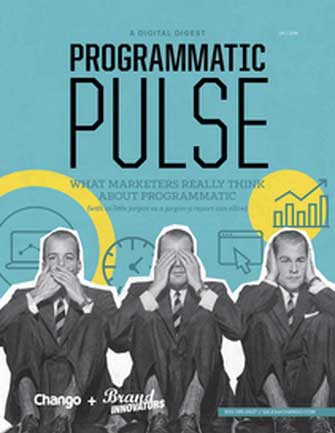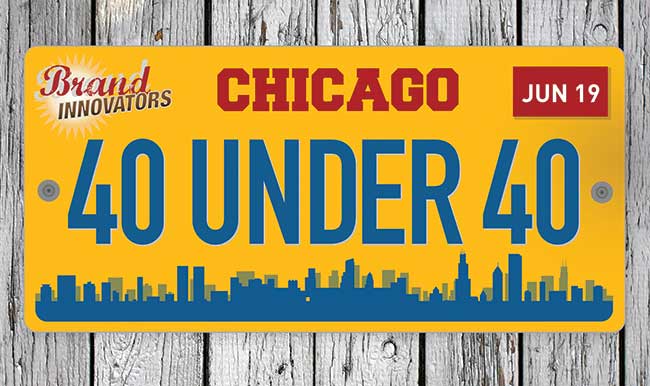Prognosticators, from eMarketer and Forrester to Business Insider, agree that we are on the cusp of an explosion in demand for Programmatic Advertising, that mix of systems, rules, and algorithms used to automate and optimize the purchase and delivery of data-driven, targeted, and relevant ads to consumers.
This explosion has created a host of questions around deploying and optimizing Programmatic Advertising, especially for the brands who’s spend is driving its rapid ascent.
To get the skinny on what is really on marketer’s minds, Chango and Brand Innovators teamed up to produce The Programmatic Advertising Pulse Report.
This report is the first ever comprehensive picture of how Fortune 500 companies (over 230 of them from multiple industries in the US, Canada and UK market completed the survey) are navigating the emerging field of Programmatic Advertising, and what key factors drive and inhibit current and future adoption and usage of Programmatic.
From this comprehensive exercise, we have identified key themes, a series of issues, and best practices, including the following top line findings:
Three of every four marketers are using Programmatic today. While approximately 70% of marketers we surveyed are currently using Programmatic, almost a third of them have been doing so less than a year. Additionally, over 30% of marketers surveyed are currently NOT using Programmatic, although about half of these respondents indicated that they intend to do so in the near future.
Room to learn, even among practitioners. Among those who use Programmatic Advertising, we saw an interesting split: three in four are firmly grounded in the ins and outs of Programmatic, either as practitioners or strategists, while one in four indicated that they need continued education on its use.
Targeting & performance are key drivers of adoption today, competitive dynamics less so. Ranking the importance of the various factors driving their use of Programmatic Advertising today, respondents revealed a clear, consistent hierarchy. Targeting across devices, improved performance, data/insights, and cost efficiencies emerged as the most important factors. Interestingly, competitive dynamics ranked at the bottom of potential issues.
Chango Bits: Programmatic Today from Chango on Vimeo.
Measurement of results, data integration, site quality/brand safety, and resource limits top issues inhibiting programmatic today. Respondents had a lot to say about things that make them think twice about shifting more dollars over to Programmatic. Measurement of results and data integration emerged as two the most important factors inhibiting usage of Programmatic today, followed closely by site quality/brand safety and lack of internal resources to manage.
How Programmatic is managed today varies immensely. Best practices have yet to emerge in the management of Programmatic efforts. Among respondents, there is a relatively equal distribution between dependency on agencies, in-house efforts, and dividing management between both agency and in-house resources.
But (internal) resource allocations seem destined to evolve. While the use of Programmatic Advertising has had minimal impact on staffing to date, this seems likely to change: over 30% of respondents are evaluating resources to better support their efforts, 7% have reallocated internal resources to the effort, and 36% felt there would be internal organization and staffing changes due to Programmatic in 2014-15.
Tactical issues keeping marketers up at night. The majority of marketers’ issues going forward are focused on the tactical application and evaluation of individual Programmatic marketing campaigns. Issues like transparency, fraud, availability of quality inventory, cost, and ROI were noted as key areas of concern.
Living in a Programmatic world The vast majority of respondents predict that their spend on Programmatic will increase next year; 19% expect significant positive change. Respondents widely agreed that a majority of digital media buying would be done Programmatically in the future and that Programmatic would expand into areas beyond online display advertising. More interesting still is that many of the executives we surveyed widely supported the notion that Programmatic would expand beyond digital media to TV in the near future.
Chango Bits: Programmatic Tomorrow from Chango on Vimeo.
Programmatic, a glass half full, or…? In general, respondents view 2015 and beyond as positive for Programmatic. They offered words like “exciting” and “promising” when asked to describe their outlook on Programmatic Advertising. That said, issues around tactical deployment of Programmatic campaigns remain, signaling a need for an industry-wide focus on sharing best practices and resolving issues such as fraud and transparency. From this, we can broadly surmise that the next several months will be a critical learning period for both current and future users of Programmatic, all of whom have committed to an increased focus on Programmatic in the coming months.
While the above is a good summary, it hardly does the complete report justice. For the full story on the pulse of programmatic, please visit the below URL:
http://www.chango.com/resources/whitepapers/pulse/?utm=brandinnovators




